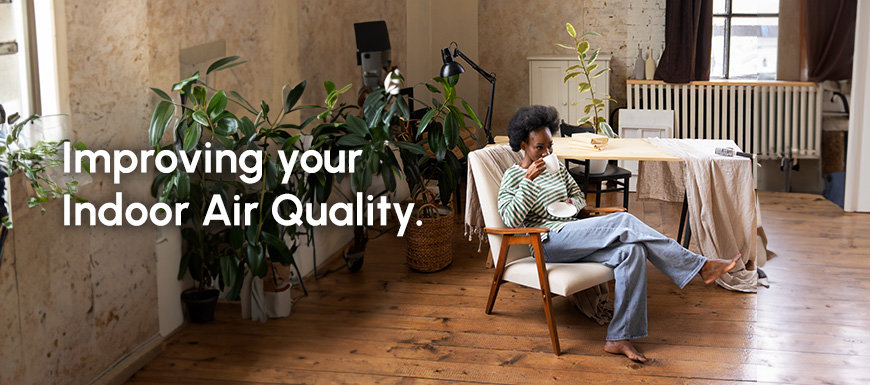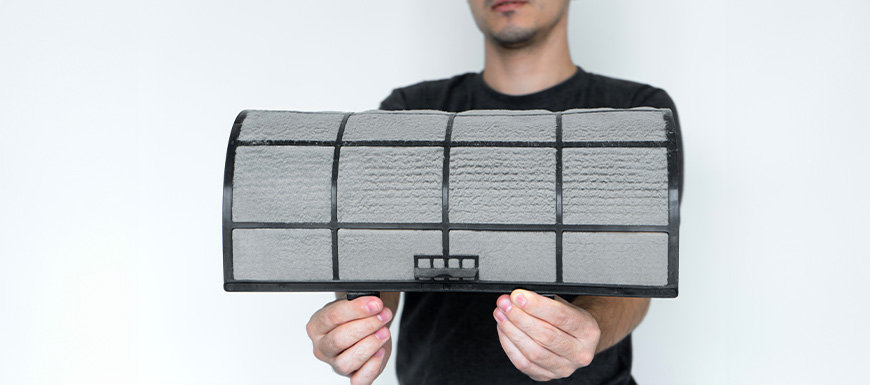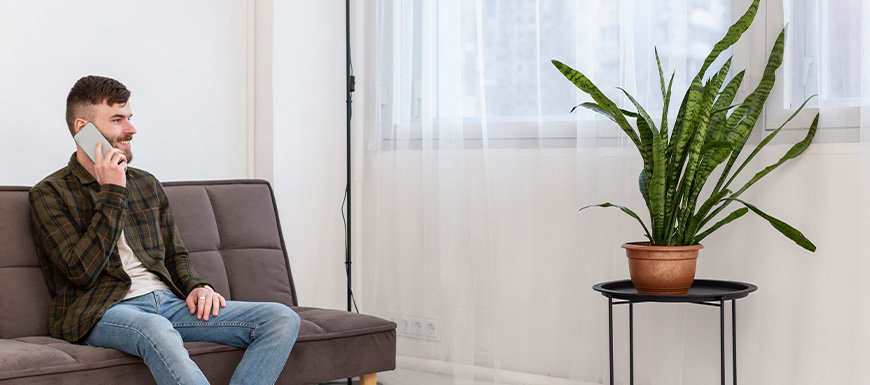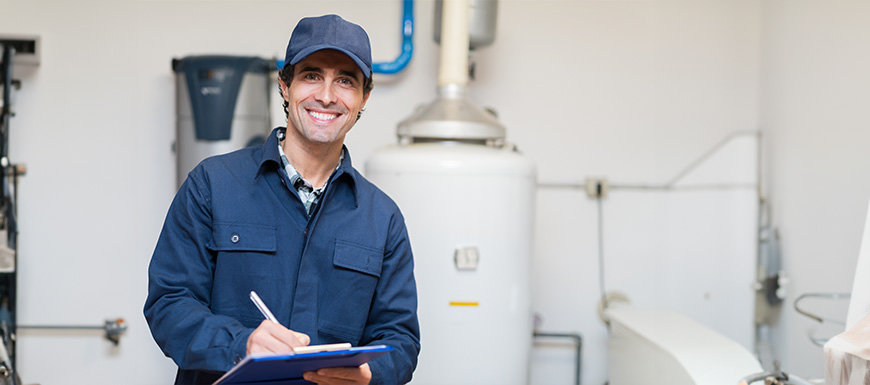
Did you ever stop to think about how much time you live indoors? Most of us spend 60 to 90% of our lifetime inside. What’s problematic is that according to the EPA, indoor air quality can be two to five times worse for us than outdoor air. We think of our homes as safe and comfortable places to be and raise our families. But what if the air we breathe, right in our homes, is causing allergies, asthma and severe disease? The good news is there are several steps you can take to improve your air quality, home comfort and health by removing airborne contaminants and air pollution. First let’s talk about what’s causing poor indoor air quality.
Causes and symptoms of indoor air pollution.
Ever noticed all those floating bits in a sunbeam or too much condensation on your windows? These can
be a sign of poor ventilation, reducing your home’s air quality, and impact your family’s health.
1. Dust mites, dander and pollen grains. All can cause mild to severe allergies resulting in a sore throat, runny nose and relentless coughing. Unlike their cousin, the common cold, these symptoms never wane and only get better with medication or when the season passes. For those that suffer from asthma, dust mites and pollen can also bring on attacks.
2. Volatile organic compounds. These chemicals are off gases from everyday products like paint, furniture, beauty and cleaner products, and cooking oils. Common symptoms include headaches, poor sleep, lethargy and an overall lack of wellness.
3. Humidity. A house with too much moisture can create the perfect environment for mould creating more allergies. Whereas if there’s too little moisture you can run into problems with dry sinuses and itchy and dry skin.
4. Bacteria and viruses. Most illnesses are caused by these biological impurities that travel through the air. They hitch a ride on big dust particles. Removing dust in your house can help control bacteria and viruses, and their spread.
Try these tips to improve the environmental health of your home.

1) Change your filters
This comes up time and time again. Your filter’s job on both your furnace and your AC system is to remove dirt, dust and pollutants from the air passing through your HVAC system. If it’s dirty so is the air. A typical central HVAC system circulates over 1,000 cubic feet per minute of air through the filter. This equals the entire air volume of your house passing through the filter multiple times every day. It means those filters are working hard!
Clogged air filters will simply recirculate dirt and debris back into your home. If you have family members that suffer from allergies or asthma this will only make their respiratory health worse. Over time poor indoor air quality can result in poor health. By changing your HVAC filters regularly, you can prevent serious problems for both your family, and improve the energy efficiency and longevity of your system.
During the winter, furnace filters should be changed every other month. In the summer, your AC filter should be replaced monthly depending on how much you have the system turned on. Or you can simply follow the manufacturer's recommendations.
Other household appliances have filters too. Vacuum cleaners, dryers, kitchen vents and bathroom exhaust fans can all get clogged. You should clean or replace these filters every few months to help remove indoor pollutants in your home.
Looking for insights on HVAC filtration options?
Delve into our informative blog post titled "Indoor Air Quality and HVAC Filtration Options" to discover how to effectively remove airborne contaminants and combat air pollution in your home with the right filtering solutions.
2)Tap into the power of plants
Not only are plants pretty, add style and ambience to your home, they are nature’s air filters. Breathing in carbon dioxide and producing oxygen, they also filter out contaminants, cleaning the air.
Here are some good houseplants for your home:

English Ivy – Easy to care for and rated by NASA as the best houseplant to filter air. English ivy is particularly good at removing formaldehyde.
Snake Plant – Want to add more oxygen? The snake plant releases oxygen during the night, while most other plants only release in the day. It also doesn't require much water or light.
Aloe Plant – With medicinal properties to treat cuts and burns, the aloe plant will also show brown spots on its leaves if there are a lot of harmful chemicals in the air, acting as a warning system to improve your indoor air quality.
Bamboo Palm – A pretty plant that is NASA approved as a great purifier, effective at removing both benzene and trichloroethylene from the air.
Rubber Tree – These trees clean the air, do well in cooler climates and poor lighting, and don’t take a lot of work. The added bonus? They efficiently remove toxins from the air.
Red-Edged Dracaena – Add some flair to your decor with this vibrant plant and clean toxins like xylene, trichloroethylene, and formaldehyde at the same time.
3)Maintain good ventilation
Ensuring a proper influx of fresh air is entering your home is important to create a healthy indoor environment. Older homes always had a built-in ventilation system, they had drafts! Gaps, cracks and holes in the building, combined with little or no insulation in the walls, allowed for fresh air to seep in. In today’s new builds, homes are almost airtight. While this allows newer homes to be more energy efficient it does exacerbate air quality. In the summer it’s easier to open the windows and doors and let the fresh air travel through your home. During the winter, not so much.
One way to increase ventilation, is to keep your furnace blower on which will bring in new filtered outdoor air and push stale unhealthy air out through your home’s ducting system. Through this process you’ll achieve a better balance, diluting indoor airborne contaminants and adding fresh air.

4)Reduce humidity
A humid house is a breeding ground for mold and mildew which can reduce the respiratory health of your family, causing allergies and asthma. As we know, new homes are sealed up tight, stopping the humidity you create in your home every day from escaping. Showers, cooking, your dishwasher and washing machine, all add moisture to your house. Never mind all the moisture in the air during rainy springs and summer thunderstorms.
What to do?
Use your exhaust fans in the bathroom and kitchen and send that moist air packing before it has a chance to settle in.
Purchase a couple of dehumidifiers to help balance out the humidity and improve your home comfort. You can also run your air conditioner more to remove humidity during the hot months.
Health Canada recommends maintaining humidity levels between 30% and 50%. To measure the humidity, buy an inexpensive hygrometer.
It’s important to know that if your home’s humidity is continually sitting above 50% you are encouraging mold. Once it’s in your house it spreads fast. Growing mold can release airborne spores by the millions. If you can’t find the balance, talk to a HVAC specialist and look at installing a whole-house dehumidifier right inside your HVAC ductwork and take charge of your humidity control.
5)Suck up the dirt and dust
When it comes to dirt and dust mites your vacuum is your best friend. Research shows that dusting and vacuuming weekly substantially reduces allergens that pollute your home and your lungs. If you live with allergy and asthma sufferers, choose your vacuum with care and look for technology that uses special HEPA filters.
And it’s not just your carpets you should worry about. Dust mites can be in your bedding, pillows, drapes and couches.
Here’s a few strategies to keep those dust mites at bay:
Mites also like humidity giving you another reason to keep your home too dry for mites to thrive. Under 50% is best.
Dust mites love the dead skin you leave behind in your bed and pillow. Change and wash your sheets weekly in hot water. Look at purchasing allergen-impermeable covers for your mattress and pillows. Research shows these covers work!
Pick hardwood, tiles or vinyl flooring and get rid of that wall-to-wall carpeting. If you have throw rugs know they help trap the dust and should be vacuumed weekly.
Always use a damp cloth to dust so you remove it; a dry cloth just whirls the dust up into the air to only settle again later.

Put your mind at ease and call a HVAC professional if you are worried about the air quality in your home. They can conduct indoor air quality testing and help determine if airborne pollutants are a problem and how to fix them. They will let you know if you need to up your game and look at adding a heat recovery ventilator (HRV) or a energy recovery ventilator (ERV). Both an HRV and ERV system will replace stale indoor air with fresh outside air. You could also consider investing in portable air purifiers or a whole home air purification system.
As we have discovered, creating a healthy indoor environment is an ongoing process with many tips and tricks to try. Know that your efforts will improve your home comfort and benefit your entire family.
